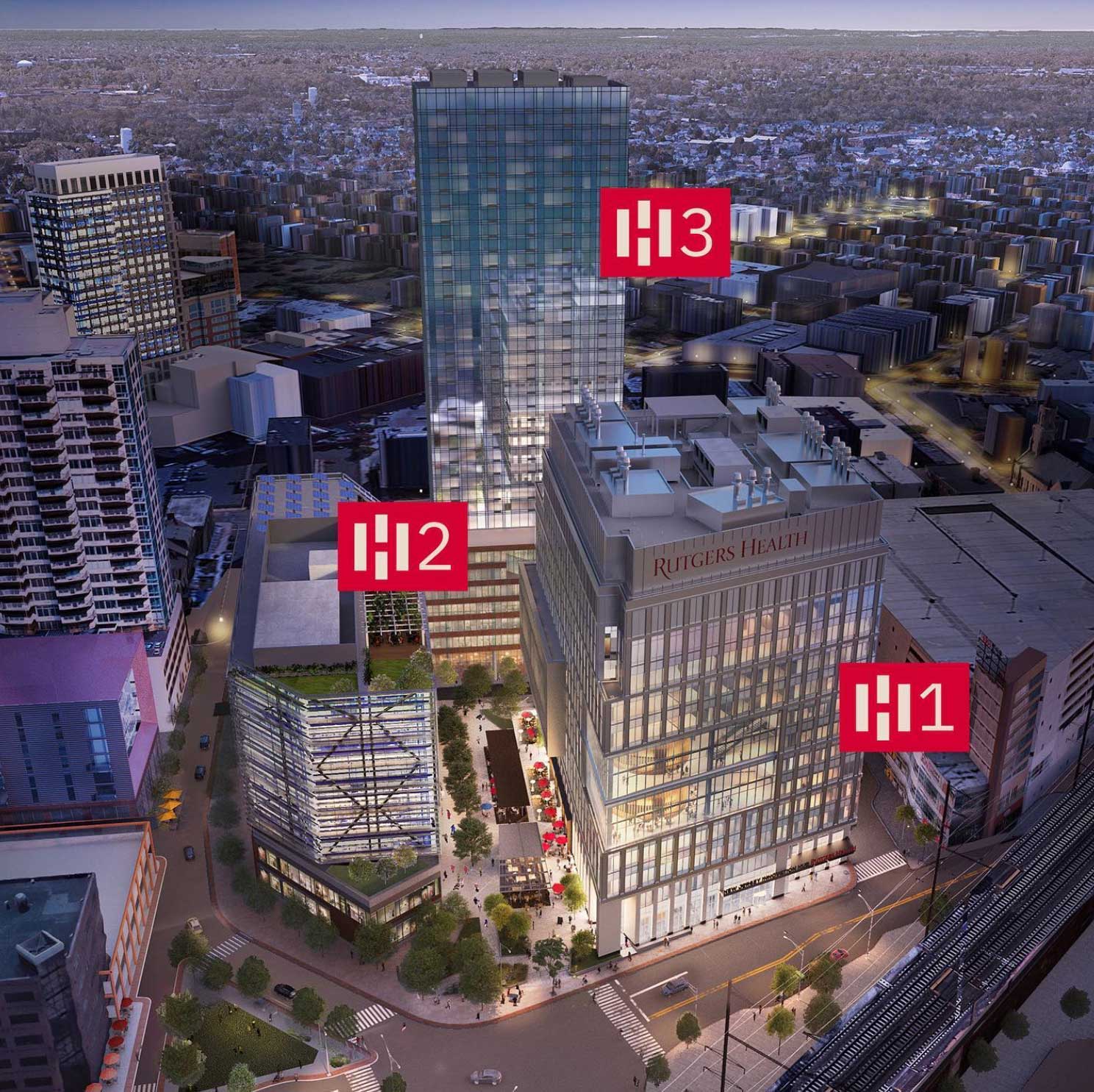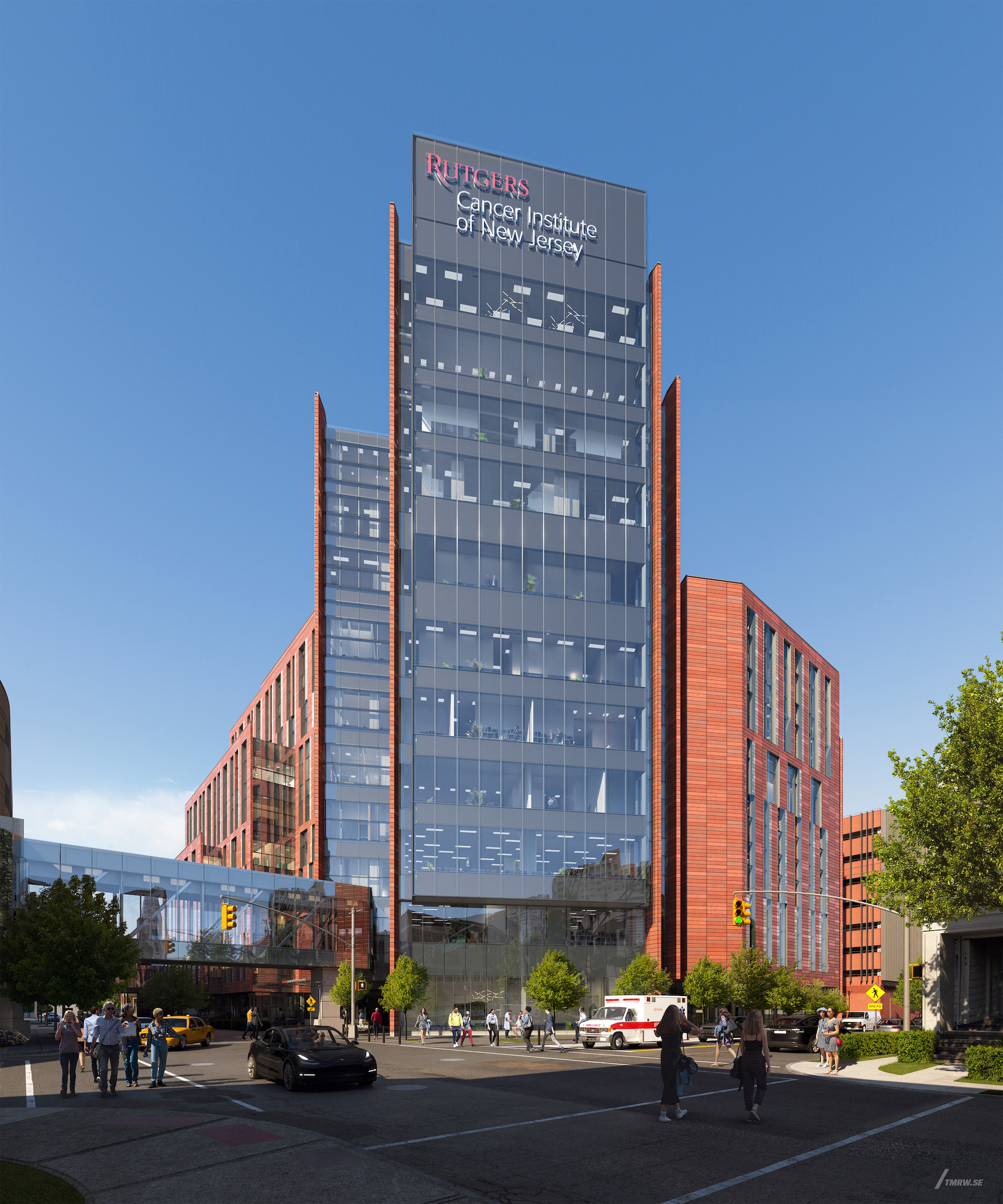Early next year, the New Brunswick (N.J.) Development Corporation, in collaboration with RWJBarnabas Health and the Rutgers Cancer Institute, is scheduled to open the Jack & Sheryl Morris Cancer Center, which will be the Garden State’s first National Cancer Institute-designated Comprehensive Cancer Center.
This 12-story, 520,000-sf, $750 million project, which broke ground in June 2021 and topped off in November 2022, will be a freestanding building that combines in- and outpatient services with research. A skywalk will connect the Cancer Center to the existing Rutgers Cancer Institute of New Jersey and the Robert Wood Johnson University Hospital.
The new building will include 96 inpatient beds on three floors, with one entire floor for surgical services. There will also be 84 infusion bays, 74 exam rooms, and state-of-the-art imaging and diagnostic equipment that includes four linear accelerators. The Cancer Center will offer in- and outpatient radiation oncology services.
More than 100 scientists will have access to 10 research labs within the Cancer Center.
The Cancer Center will be integrated into RWJBarnabas’ “Navigator” program, which allows patients to take a more active part in managing their treatment and longer-term healthcare.
The Building Team for the Cancer Center includes HOK (architect and designer), a joint venture between Jingoli Construction and LF Driscoll (GC), and O’Donnell & Naccarato (SE). As part of this project, RWJBarnabas picked up the $55 million tab to build Blanquita B. Valenti Community School, a three-story elementary school for 800 students that opened last September. Jack Morris, the Cancer Center’s benefactor and namesake, is the founding chairman of RWJBarnabas Health, and with his wife leads Edgewood Properties, a property development and management firm.
An innovation hub in the city’s core

The Morris Cancer Center isn’t the only project that’s positioned to reshape New Brunswick’s reputation, urban landscape, and economy, at a time when this city of 56,400 is only growing marginally and has struggled to maintain its jobs base. After years of languishing as a massive excavation hole, The Health and Life Science Exchange (HELIX NJ), a four-acre innovation district which was co-developed by SJP Properties and the New Brunswick Development Corporation, finally began construction last July and is scheduled to start opening next year.
HELIX’s $650 million first phase, a 13-story 573,400-sf building, will house an Innovation HUB, Rutgers Robert Wood Johnson Medical School (on four floors), and a research facility, as well as retail space, a 10,000-sf market hall, and a 3,000-sf restaurant that opens onto a 70-ft-wide plaza.
Rutgers University, which will occupy three-quarters of HELIX’s first building, has committed $270 million to recruit and retain 80 translational research investigators to work in HELIX.
HELIX’s $731 million second phase, designed by HDR, will include 600,000 sf of built-to-suit office and lab space. (Last month, Nokia announced plans to move Nokia Bell Labs into HELIX.) Phase 3 will be a mixed-use 42-story building with 220 housing units. Jingoli Construction is HELIX’s general contractor.
HELIX was the first program approved under the New Jersey Economic Development Authority's Aspire tax credit program, which was created by legislation passed in 2020.
Related Stories
Project + Process Innovation | Mar 22, 2023
Onsite prefabrication for healthcare construction: It's more than a process, it's a partnership
Prefabrication can help project teams navigate an uncertain market. GBBN's Mickey LeRoy, AIA, ACHA, LEED AP, explains the difference between onsite and offsite prefabrication methods for healthcare construction projects.
Modular Building | Mar 20, 2023
3 ways prefabrication doubles as a sustainability strategy
Corie Baker, AIA, shares three modular Gresham Smith projects that found sustainability benefits from the use of prefabrication.
Building Tech | Mar 14, 2023
Reaping the benefits of offsite construction, with ICC's Ryan Colker
Ryan Colker, VP of Innovation at the International Code Council, discusses how municipal regulations and inspections are keeping up with the expansion of off-site manufacturing for commercial construction. Colker speaks with BD+C's John Caulfield.
Healthcare Facilities | Mar 13, 2023
Next-gen behavioral health facilities use design innovation as part of the treatment
An exponential increase in mental illness incidences triggers new behavioral health facilities whose design is part of the treatment.
Healthcare Facilities | Mar 6, 2023
NBBJ kicks off new design podcast with discussion on behavioral health facilities
During the second week of November, the architecture firm NBBJ launched a podcast series called Uplift, that focuses on the transformative power of design. Its first 30-minute episode homed in on designing for behavioral healthcare facilities, a hot topic given the increasing number of new construction and renovation projects in this subsector.
Sustainability | Mar 2, 2023
The next steps for a sustainable, decarbonized future
For building owners and developers, the push to net zero energy and carbon neutrality is no longer an academic discussion.
University Buildings | Feb 23, 2023
Johns Hopkins shares design for new medical campus building named in honor of Henrietta Lacks
In November, Johns Hopkins University and Johns Hopkins Medicine shared the initial design plans for a campus building project named in honor of Henrietta Lacks, the Baltimore County woman whose cells have advanced medicine around the world. Diagnosed with cervical cancer, Lacks, an African-American mother of five, sought treatment at the Johns Hopkins Hospital in the early 1950s. Named HeLa cells, the cell line that began with Lacks has contributed to numerous medical breakthroughs.
Healthcare Facilities | Feb 21, 2023
Cleveland's Glick Center hospital anchors neighborhood revitalization
The newly opened MetroHealth Glick Center in Cleveland, a replacement acute care hospital for MetroHealth, is the centerpiece of a neighborhood revitalization. The eleven-story structure is located within a ‘hospital-in-a-park’ setting that will provide a bucolic space to the community where public green space is lacking. It will connect patients, visitors, and staff to the emotional and physical benefits of nature.
Multifamily Housing | Feb 16, 2023
Coastal Construction Group establishes an attainable multifamily housing division
Coastal Construction Group, one of the largest privately held construction companies in the Southeast, has announced a new division within their multifamily sector that will focus on the need for attainable housing in South Florida.
Intelligent Lighting | Feb 13, 2023
Exploring intelligent lighting usage in healthcare, commercial facilities
SSR's Todd Herrmann, PE, LEEP AP, explains intelligent lighting's potential use cases in healthcare facilities and more.

















